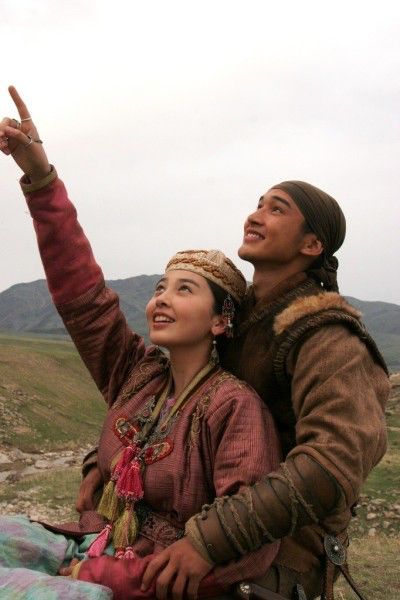ASTANA – The new format of the Nauryz celebration in Kazakhstan has introduced the National Clothing Day on March 18 with a wide range of festivities aimed at popularizing traditional attire of the Kazakh nation, leaving space for modern interpretation of centuries-old patterns.

Domestic cinematography often presents actors in traditional clothing. An excerpt from the music video titled “Medina” directed by Kazakh filmmaker Aisultan Seitov. Photo credit: kazpravda.kz.
As part of the third meeting of the National Kurultai (Congress) on March 15, Kazakh President Kassym-Jomart Tokayev emphasized the crucial task of strengthening national identity by promoting national clothes.
“Each day now has its own name during the festive period starting with Korisu day. One of them is dedicated to national clothing, which should represent us globally. Last year, during the Auyzashar (the evening meal after sunset during Ramadan), I specifically addressed this issue. It is essential to support and expand this commendable initiative,” said Tokayev.

A scene from the Kazakh movie “Zhauzhurek Myn Bala” (“Thousand Young Warriors”). Photo credit: youtube.com.
“Some major companies and educational institutions are already adopting the practice of wearing attire in the national style,” he added.
The Kazakh capital launches a campaign on national clothing in front of the Atameken Map of Kazakhstan ethno-memorial complex with the participation of cultural figures and theater artists.
On the same day, the Sana center for extra-curricular education hosts a thematic exhibition for students about the history and ideology of national dress.
Last month, Daulet Mukayev, the member of Mazhilis (the lower house of the Kazakh Parliament) came up with the idea to establish the National Clothing Day at the state level. He suggested introducing a standard of national clothing for schoolchildren and incorporating elements of Kazakh identity into the wardrobe of civil servants.
“Our country can take pride in the rich heritage of our national clothing. We boast over 20 types of traditional headwear alone, not to mention other garments. Today, our national attire is widely represented not only in Kazakhstan but also in other countries,” said Mukayev.
He also called for state support for domestic businesses engaged in the production of national clothing. Lately, Kazakh entrepreneurs have significantly popularized clothing of domestic production with traditional patterns, as the population has shown a great demand for local brands, such as the Qazaq Republic, Arlem, Shakerbay, Arunaz, Kaidarova, Shoqan, Argymaq, and many other bright newcomers in the market.
Local designers are also creating modern chapans (a traditional gown), trendy camisoles (a traditional styled jacket), and national embroidered takiya (skullcap hat) that have become practical and fashionable wardrobe items.
On this festive occasion, the vibrant urban life in Almaty will be also filled with a raft of special events. The city boasts the highest population in the country, with over 2.2 million residents.
The major one, the Fashion Show national clothing competition, will be held in the Zhambyl Kazakh State Philharmonic on March 18. Young designers will present modern interpretations of customs and traditions.
The Shugyla district will become a venue for another design event – the Tumar (Talisman) fashion week, where local professional tailors will showcase their artworks to the public. In Kazakh culture, talismans are believed to usher in good fortune, reflecting the diversity of cultural practices.

Kazakh Fashion Week 2018 at the National Academical Theater of Opera and Ballet in Almaty. Photo credit: kazpravda.kz.
Kazakh jewelry, which is an essential element of a complete outfit, has ancient origins and reflects diverse cultural practices. The jewelry art is heavily based on the symbolism of ancient Turkic ornaments filled with sacred meaning.
On the following day, the Zhambyl Youth library will unveil a book exhibition titled “Oyu men oyi” (The ornament and the thought). The idea of the event is to feature depictions of Kazakh folk ornaments and traditional attire.
The dolls will also captivate audiences adorned in traditional costumes and decorations. On March 19, the State Puppet Theater will organize an exhibition of dolls in national attire for both children and adults.
On the background of the listed activities, the Arbat street, which is a stomping ground for local citizens, is holding a handmade fair. The fair, organized by the Union of Ethnodesigners, will last through March 24.


